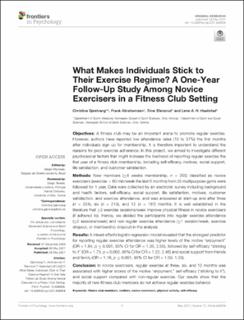What makes individuals stick to their exercise regime?: A one-year follow-up study among novice exercisers in a fitness club setting
| dc.contributor.author | Gjestvang, Christina | |
| dc.contributor.author | Abrahamsen, Frank Eirik | |
| dc.contributor.author | Stensrud, Trine | |
| dc.contributor.author | Haakstad, Lene Annette Hagen | |
| dc.date.accessioned | 2021-11-04T15:01:17Z | |
| dc.date.available | 2021-11-04T15:01:17Z | |
| dc.date.created | 2021-05-31T20:18:33Z | |
| dc.date.issued | 2021 | |
| dc.identifier.citation | Frontiers in Psychology. 2021, 12(2021), Artikkel 638928. | en_US |
| dc.identifier.issn | 1664-1078 | |
| dc.identifier.uri | https://hdl.handle.net/11250/2827971 | |
| dc.description | This is an open-access article distributed under the terms of the Creative Commons Attribution License (CC BY). The use, distribution or reproduction in other forums is permitted, provided the original author(s) and the copyright owner(s) are credited and that the original publication in this journal is cited, in accordance with accepted academic practice. No use, distribution or reproduction is permitted which does not comply with these terms. | en_US |
| dc.description.abstract | Objectives: A fitness club may be an important arena to promote regular exercise. However, authors have reported low attendance rates (10 to 37%) the first months after individuals sign up for membership. It is therefore important to understand the reasons for poor exercise adherence. In this project, we aimed to investigate different psychosocial factors that might increase the likelihood of reporting regular exercise the first year of a fitness club membership, including self-efficacy, motives, social support, life satisfaction, and customer satisfaction. Methods: New members (≤4 weeks membership, n = 250) classified as novice exercisers (exercise < 60 min/week the last 6 months) from 25 multipurpose gyms were followed for 1 year. Data were collected by an electronic survey including background and health factors, self-efficacy, social support, life satisfaction, motives, customer satisfaction, and exercise attendance, and was answered at start-up and after three (n = 224), six (n = 213), and 12 (n = 187) months. It is well established in the literature that ≥2 exercise sessions/week improve physical fitness in novice exercisers (if adhered to). Hence, we divided the participants into regular exercise attendance (≥2 sessions/week) and non-regular exercise attendance (≤1 session/week, exercise dropout, or membership dropout) in the analysis. Results: A mixed-effects logistic regression model revealed that the strongest predictor for reporting regular exercise attendance was higher levels of the motive “enjoyment” (OR = 1.84, p ≤ 0.001, 95% CI for OR = 1.35, 2.50), followed by self-efficacy “sticking to it” (OR = 1.73, p = 0.002, 95% CI for OR = 1.22, 2.46) and social support from friends and family (OR = 1.16, p ≤ 0.001, 95% CI for OR = 1.09, 1.23). Conclusion: In novice exercisers, regular exercise at three, six, and 12 months was associated with higher scores of the motive “enjoyment,” self-efficacy (“sticking to it”), and social support compared with non-regular exercise. Our results show that the majority of new fitness club members do not achieve regular exercise behavior. | en_US |
| dc.language.iso | eng | en_US |
| dc.subject | fitness club members | en_US |
| dc.subject | motives | en_US |
| dc.subject | novice exercisers | en_US |
| dc.subject | physical activity | en_US |
| dc.subject | self-efficacy | en_US |
| dc.title | What makes individuals stick to their exercise regime?: A one-year follow-up study among novice exercisers in a fitness club setting | en_US |
| dc.type | Peer reviewed | en_US |
| dc.type | Journal article | en_US |
| dc.description.version | publishedVersion | en_US |
| dc.rights.holder | © 2021 Gjestvang, Abrahamsen, Stensrud and Haakstad | en_US |
| dc.source.pagenumber | 9 | en_US |
| dc.source.volume | 12 | en_US |
| dc.source.journal | Frontiers in Psychology | en_US |
| dc.identifier.doi | 10.3389/fpsyg.2021.638928 | |
| dc.identifier.cristin | 1912937 | |
| dc.description.localcode | Institutt for idrettsmedisinske fag / Department of Sports Medicine | en_US |
| dc.description.localcode | Institutt for idrett og samfunnsvitenskap / Department of Sport and Social Sciences | en_US |
| dc.source.articlenumber | 638928 | en_US |
| cristin.ispublished | true | |
| cristin.fulltext | original | |
| cristin.qualitycode | 1 |
Files in this item
This item appears in the following Collection(s)
-
Artikler / Articles [2119]
-
Publikasjoner fra Cristin [1107]
